Introduction
Within This Page
Moisture in buildings is a major contributor to mold growth, unhealthy buildings, and poor indoor air quality. Wetting of building walls and rainwater leaks are major causes of water infiltration, but so is excessive indoor moisture generation. Preventive and remedial measures include rainwater tight detail design; prevention of uncontrolled air movement; reduction of indoor air moisture content; reduction of water vapor diffusion into walls and roofs; selection of building materials with appropriate water transmission characteristics; and proper field workmanship quality control.
A successful method for deterring rainwater intrusion into walls is the rain screen approach, which incorporates cladding, air cavity, drainage plane, and airtight support wall to offer multiple moisture-shedding pathways.
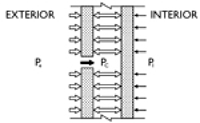
Figure 1: Rain Screen
The concept of the rain screen principle is to separate the plane in a wall where the rainwater is shed and where the air infiltration is stopped. In terms of construction, this means that there is an outer plane which sheds rainwater but lets air freely circulate, and an inner plane which is relatively airtight. In terms of pressures, there is no pressure differential across the outer pane and there is a significant pressure differential across the inner plane. Because there is no pressure difference across the outer plane, there is no driving force to move water indoors; because there is no water present at the inner plane, no water will penetrate the inner plane despite the presence of the driving force of the pressure difference.
Description
A. Mold
Molds are part of the natural environment and are present everywhere. They are usually not a problem indoors. The medical community appears to be divided regarding the threat of mold, but seems to agree that some people with allergies are sensitive to mold and that in sensitive individuals mold can lead to respiratory diseases.1, 2 The issue with mold then is not to prevent any mold growth, or to eliminate any existing mold growth, but to control it within acceptable limits.
To grow, or to establish itself, mold requires at least four elements: mold spores, organic matter (like wood, paper, and drywall), moisture, and warmth. Note that the mere presence of humid air does not necessarily promote mold growth, except where air with a relative humidity (RH) level at or above 80% is in contact with a surface. Carried by air currents, mold spores can reach all surfaces and cavities of buildings. If these surfaces and/or cavities are warm, and contain the right nutrients and amounts of moisture, the mold spores will grow and gradually destroy the things they grow on. To control mold growth, designers should focus on controlling moisture indoors and on the temperatures of all surfaces, including interstitial surfaces within walls.
In addition to mold, other organisms such as bacteria, mites, cockroaches, and insects that are known to infest buildings also depend on moisture. And finally, excessive high moisture content of thermal insulations reduces effective insulation rates by as much as 50%. For all these reasons, moisture control must be a primary consideration in both the design of new buildings and in the renovation of existing structures.
The remainder of this Resource Page will focus on the sources of excessive moisture and some strategies to prevent water infiltration into buildings.
B. Moisture Dynamics Concepts and Definitions
Psychrometrics: The study of air-water mixtures is called psychrometric. The relationship between air temperature, moisture content, and humidity has been codified in a diagram called the psychrometric chart that is indispensable for understanding condensation. Among other things, it indicates the dew point temperature of any air-water vapor mixture.
Water Vapor Permeance and Permeability: Permeability is a material property; permeance is a product property. For board materials, usually permeability is given; for thin membranes, it is customary to provide their permeance.
-
Permeance: The rate of water vapor transmission through unit area of a flat product induced by unit vapor pressure between its two surfaces. In Inch/Pound units, Permeance is given in the unit "perm," where one perm equals a transmission rate of 1 grain of water per hour for each square foot of area per inch of mercury (gr/hft2in.Hg). (1 grain is 1/700 of a pound.) In Metric/SI units, Permeance is given in nanograms of water per second per second for each square meter of area per Pascal of Vapor pressure (ng/som2oPa). One perm equals a flow rate of 57 ng/sm2Pa.
-
Permeability: The time rate of water vapor transmission through unit area of a material of unit thickness induced by unit vapor pressure difference between its two surfaces. In Inch/Pond units, permeability is given as "perm," where one perm equals a transmission rate of 1 grain of water per hour for each square foot of area per inch of mercury (gr/hftin.Hg). Permeability is also sometimes given as perm per inch. In Metric/SI units, permeability is given in nanograms of water per second for each square meter of area per thickness in meters per Pascal of Vapor pressure (ng/smPa).
Vapor and Air Retarders: These materials inhibit the uncontrolled flow of air and water vapor through the building envelope:
-
Vapor Retarders: A membrane or paint film having a water vapor transmission rate of less than one perm, used to reduce the rate and volume of water vapor diffusion through ceilings, walls, or floors. Membranes are generally thin flexible materials, such as polyethylene, while coatings are typically of asphaltic, resinous, or polymeric composition and applied by trowels or brushes (for more product information, see Product Suppliers and Manufacturers section below).
-
Air Retarder: A membrane having a water vapor permeance of no less than 5 perm restricting the flow of air to l/s and used to reduce air infiltration and exfiltration through a building assembly, yet allowing water vapor to easily diffuse though it. A common type of air retarder is composed of fiber-reinforced polyolefin. All joints and seams in air retarders must be sealed to create an effective air retarder. ASTM International specifies that a material must have a perm rating of 5.0 or higher to qualify as an air retarder. See also WBDG Air Barrier Systems in Buildings. So that it is possible to seal an air retarder correctly, the wall needs to be detailed carefully and with the sequence of installation in mind.
-
Air/Vapor Retarders: A membrane meeting the water vapor resistance rating of a vapor retarder combined with the air infiltration characteristics of an air retarder, used to restrict both the rate and volume of air and of water vapor through ceilings, walls, and floor elements. Air/vapor retarders may be constructed from polyethylene, extruded polystyrene, foil-covered foams, and exterior sheathings. All joints, air/vapor retarders seams, and penetrations, including at windows, doors, electrical outlets, plumbing stacks, and vents must be effectively sealed. Detailing and installation requirements for Air/Vapor Retarders are the same as for Air Retarders.
Figure 2: Installation of Combined Air and Water Retarder
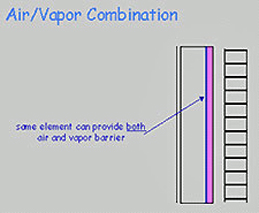
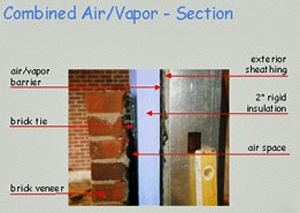
The same material can be both an air and vapor retarder.
Courtesy of Commonwealth of Massachusetts
The photo shows a system that uses a peel-and -stick material as both the vapor retarder and air retarder. The material is installed over the gypsum sheathing but on the warm-in-winter side of two inches of extruded polyethylene insulation.
Courtesy of Commonwealth of Massachusetts
Moisture Movement: Moisture can move through and into building components in three major ways: by rainwater impingement or leakage, movement of moisture laden air, and by diffusion.
-
Rainwater Impingement and Leakage: Even though rain is infrequent in some parts of the U.S., rainwater leaks and impingement are potentially the greatest contributors to water in building elements. Unless a roof or wall is seriously deteriorated, rainwater has the tendency to enter at discrete locations, which can more easily be identified and stopped. Further, as a rule rains are followed by dry weather, allowing the wall or roof to dry out.
-
Movement of Moist Air (Mass Transport): Because of air pressure differences, air moves into and out of building walls due to wind action, stack effect, or due to the action of mechanical ventilation. Mass transport of water through air movement is potentially the second most important mechanism for moisture intrusion into building walls and roofs. However, the air pressure difference and the air and moisture movement into or out of the building envelope can change drastically depending on wind direction and speed, level in the building, and operation of the mechanical system.
-
Vapor Diffusion: Differences in water vapor pressures between inside and outside of the building envelope cause water vapor to move by diffusion through the building envelope and through building materials. Water vapor will be driven from high vapor pressure areas to lower pressure; in winter from the inside toward the exterior; in air-conditioned buildings in warm climates toward the interior. Diffusion of moisture through envelope materials is generally a slow process, and in terms of the amount of moisture transfer, it is potentially far less serious than mass transport. Diffusion can be fairly steady over long periods, possibly on a seasonal basis, and reversals, which would dry out the cavities, are less frequent. Because of this, diffusion can still lead to significant amounts of water transport and accumulation within building envelopes and their constituent materials over long periods with attendant significant potential to cause deterioration.
- Although rainwater and mass transport of moisture through air movement are likely to be many times greater than diffusion, it does not necessarily follow that damage from rainwater and air movement is also that many times greater.
- Rain is intermittent and allows drying out between rainfalls.
- The moisture transported by moist air is significant, but not all the moisture is deposited within the construction; some passes harmlessly through the building envelope.
- Air movement is often dependent on wind direction. When the direction changes, so does the direction of the air movement, wetting becomes drying.
- Both rainwater leaks and air leaks generally occurs at discrete locations (e.g., cracks, joints) and do not affect the wall or roof over their entire surface.
- Diffusion is a slow process but changes direction infrequently. Moisture can move by diffusion into wall cavities over a period of several months without reversal, slowly saturating materials and causing deterioration.
C. Sources of Excessive Moisture in Buildings and their Reduction
Excessive moisture in buildings can result from a number of causes:
- Rainwater leaks through roofs and walls
- Leakage of moist air
- Diffusion of moisture through walls, roofs, and floors
- Groundwater intrusion into basements and crawl spaces through walls and floors
- Leaking or burst water pipes
- Indoor moisture sources and
- Construction moisture.
Rainwater Leaks: The control of rainwater leaks has been the subject of good building practices for as long as human habitations have been built. Even infrequent but serious leaks during heavy storms can lead to mold infestation, are annoying, and can cause serious damage to buildings and their contents. Less severe but more frequent leaks and slow but persistent leaks can cause equally serious damage.
Leakage of Moist Air: Warm and moist indoor air condenses on cold surfaces and interstitial planes inside constructions. This moisture can be stored harmlessly within construction materials or can cause mold growth and deterioration. Excessive moisture content in wood can cause mold growth and dry rot on wood, rust on unprotected steel, and loss of insulating value in thermal insulations.
Duffusion of Moisture through Walls, Roofs, and Floors: Diffusion, as a result of differing vapor pressures across walls or roofs moves moisture through building materials. Materials with low permeancies allow little vapor transmission; materials with high permeancies allow more moisture transmission. Convention calls materials with a Permeance of 1 perm (in SI units, 57 nanogramsof water per second for each square meter of area) "vapor retarders." Note that the diffusion is dependent on vapor pressure resulting from differences in temperature and relative humidity of the air on the two sides of the wall or of individual materials.
Groundwater Intrusion: Intrusion of groundwater into basements and crawl spaces is common. This can result from a high water table or from rainwater runoff soaking into the ground at the basement/crawl space walls. Because most basements and crawl spaces are connected through cracks, pipe chases, and stairways to the rest of the building, moist air from wet basements and crawl spaces will find their way into occupied and other spaces above.
Leaking or Burst Water Pipes: The prevention and repair of burst or leaking pipes is the responsibility of plumbers. Except for old steel and iron pipes and frozen pipes, there should be little concern for this issue. However, in some geographic areas, recently installed copper pipes have been found to develop small pinhole penetrations leading to slow but constant leaks. In general, correctly installed pipes made of quality materials should not be a problem for many years after installation.
Indoor Moisture Sources: Human occupancy: breathing, perspiration, cooking, bathing, and clothing washing can add significant amounts of moisture to buildings. Kitchens and bathrooms should be independently vented and washers need to be vented outdoors. Open sumps, aquariums, indoor swimming pools, and hot tubs, as well as excessive indoor plants can increase indoor humidity beyond the recommended 30 to 50 percent. Moisture sources should, where possible, be covered by tight lids when not in use.
Construction Moisture: Wet construction materials, such as in-situ cast concrete and lumber stored unprotected outdoors prior to installation can increase indoor humidity significantly during the first one to two years of occupancy.
D. Design Recommendations
The traditional way of preventing moisture problems in walls and roofs was the installation of what then was called vapor barriers, now more accurately referred to as vapor retarders. There are a few commonly quoted, prescriptive rules of thumb for locating vapor retarders in walls and roofs, some of which are listed below. While these rules still may be useful as first cut approximations, the designer must consider the entire array of good practices, needs to conduct a job specific analysis, and must understand local climatic conditions and building practices.
-
Rainwater leaks and wetting of permeable wall exteriors are recognized as the major moisture transport mechanisms into walls. Therefore, shedding of rainwater, roof overhangs, and appropriate water repellant finishes should be considered to reduce moisture infiltration into wall constructions.
-
Rainwater leaks are most common at the joints between components, notably between walls and windows and doors, at sills, and at roof/wall intersections. Specify appropriate sealants to prevent water infiltration.
-
Some new materials have not withstood the test of time nor have reliable test methods. Therefore, designers specifying innovative materials must carefully review available data regarding performance, compatibility, and installation requirements.
-
Building walls can be classified as "face sealed" or as "drained" walls. Face sealed walls have only one single defense against rainwater. An example is face sealed Exterior Insulation and Finish Systems (EIFS) aka synthetic stucco. Unless perfectly or near perfectly installed, face sealed walls will fail and so adequate provision for field quality control in the specifications is mandatory. Drained walls have a secondary barrier to water penetration and provide a means to drain water that may have penetrated the first water barrier. An example would be masonry veneer walls that include a drain cavity.
-
To prevent water accumulation in basements and crawl spaces: seal the below-grade walls; install a vapor retarder and a capillary break on the floor of the crawl space or below the basement floor slab; install drains and sumps; drain downspouts and rainwater runoff away from the building; and slope the grade away from the foundation. See also WBDG Achieving Sustainable Site Design through Low Impact Development Practices.
-
Movement of moisture-laden air into wall and roof cavities is the second most prominent moisture transport mechanism. Accordingly, select construction details that prevent moist air from infiltrating. In cold climates during the winter, this means prevent indoor air from exfiltrating through the wall; in warm climates, prevent moist outside air from infiltrating. Pressurization and depressurization of the indoor space can assist in this effort. However, in high-rise buildings, stack effect may negate pressure gradients resulting from mechanical ventilation. See also WBDG Air Barrier Systems in Buildings.
-
In cold climates, locate the vapor diffusion retarder on the warm side of the exterior insulation. Some building scientists suggest including an interior vapor retarder only in cold climate areas with 8,000 heating degree-days or above, but no long-term empirical data exists to justify this practice at this time.
-
In cooling-dominated climates, install a vapor retarder on the exterior of the insulation. In mixed zones—climates with both significant heating and cooling requirements—omit a vapor diffusion retarder in favor of more attention to air leakage control. In warm and humid climates, consider installing a vapor impermeable finish on the exterior.
-
As a rule, it is better to omit a vapor retarder than to install one where it is not required. Never install vinyl wallpaper on the interior of exterior walls in warm climates.
- Eliminate the possibility for water vapor to condense within a building assembly. This can be achieved a number of ways:
- Seal building assemblies and/or install an air retarding membrane to reduce air leakage into wall/ceiling cavities. Pay particular attention to penetrations between conditioned and unconditioned spaces as a result of plumbing stacks, wiring, ductwork, electrical outlets, etc.
- Incorporate vapor retarding membranes that inhibit the diffusion of warm, humid air into the building wall cavities;
- Reduce open water sources and protect building materials from the elements prior to installation; and
- Coordinate the performance of the building's heating and cooling system so as to control the indoor air humidity and the pressure of the indoor air relative to the pressure of the exterior. Ideally, maintain the indoor relative humidity between 30% and 50%. See also WBDG High-Performance HVAC.
- Provide clear specifications that include appropriate and effective field quality control and inspection provisions, which are as important as proper design and material selection. Clarify whether a vapor diffusion retarder, an air retarding membrane, an air retarder construction approach, or some combination of these strategies will be used in the building. Include requirements for environmental conditions when sealers and caulks can be applied.
E. Methods of Construction
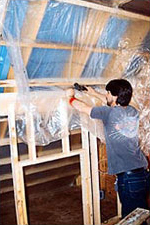
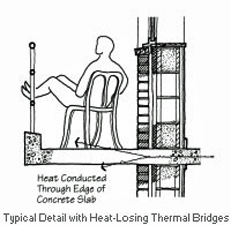
Proper installation is as important as a good design in preventing water infiltration.
Thermal bridges through building envelopes can cause condensation and cold interior surfaces. One solution is to install insulation both on the floor and ceiling of the concrete slab for a few feet.
Following are some issues to consider and strategies to implement during construction to prevent moisture infiltration:
-
Make sure all vapor retarders and air-retarding systems are installed continuously. These systems are only as effective as their weakest point. Make sure all joints and penetrations are sealed. See also WBDG Air Barrier Systems in Buildings.
-
When using coatings with low perm ratings, specify the sealing of all cracks at joints and penetrations to prevent air leakage. The Airtight Drywall Approach (ADA) and Simple Caulk and Seal (SCS) are two approaches that rely on coated materials with effective air sealing instead of polyethylene wrapping.
-
Pay careful attention to potential thermal bridges through building envelopes that can cause cold interior surfaces and condensation. Elements such as continuous cantilevered beams or balcony slabs and exposed soffits can create moisture problems.
-
In retrofits, installing a separate vapor diffusion retarder is usually cost-prohibitive. "Vapor retarder" paints are an effective option in this case. Most paint experts agree that, for this purpose, glossy paints work better than flat paints; acrylic paints are generally better than latex paints; and the more coats applied, the better.
F. Analysis and Design Tools
Always conduct a job specific moisture analysis. The only exception would be for a building that is identical or very similar to an existing successful building in the same general location, has the same occupancy, and is constructed of the same materials. The analysis can be a simple manual or graphic method, or, preferably, a computer-based model. As a rule, analysis methods apply to "typical" wall sections. It must be recognized that thermal breaks, corners, window surround details, and other anomalies can be the critical elements and analysis results must therefore be used with care.
Manual Method—Dew Point Method, Glaser, and Kieper Diagrams: All manual methods are based on steady-state analysis. That is, the analysis is made for specific conditions, which that designer selects. It is recommended that the analysis be made for more than one set of assumed conditions; specifically, for both summer and winter conditions. Manual methods are primarily useful for comparing similar wall designs or walls incorporating different wall materials.
Computer-Based Methods are based on dynamic analysis using weather data for specific locations. Most use hourly weather data. The most commonly used methods are MOIST, developed by the National Institute of Standards and Technology (NIST), and WUFI, developed jointly by Oak Ridge National Laboratory (ORNL) and the Fraunhofer Institute for Building Physics (IBP). The advantage of these programs is that they model the moisture and thermal conditions of a selected design over a period, usually over a one- to two-year cycle, using typical weather data. The more advanced models include such refinements as the effect of water impingement on walls, and air and water leakage. However, in many instances the designer has little or no data to develop rational input data. For this reason, less sophisticated models serve the practitioner almost as well as the most sophisticated ones.
Application
All structures should be concerned with moisture control. Special attention must be given to facilities which have a propensity to generate high interior humidity, such as indoor swimming pools, commercial kitchens and laundries, hot tubs, gymnasiums, tennis courts with Har-Tru® or similar surfaces, and all air-conditioned buildings in warm and humid climates.
Relevant Codes and Standards
- ASHRAE Handbook—Fundamentals by American Society of Heating, Refrigeration, and Air-Conditioning Engineers, (revised every 4 years).
Additional Resources
Organizations
- American Industrial Hygiene Association—A professional association that has a series of articles on mold, as well as a list of accredited laboratories for mold testing.
- American Lung Association—A voluntary health organization that, among other things, provides easy to understand information on health aspects of mold and air quality topics.
- ASTM International—Publishes reference material on specifying retarding materials.
- Insulation Institute/North American Insulation Manufacturers Association (NAIMA)—A trade association for manufacturers of fiberglass, rock wool, and slag wool insulation.
Product Suppliers and Manufacturers
- Information on air and vapor retarding products can be found under Construction Specification Institute Division 7: Thermal and Moisture Protection—Section 07260 Vapor Retarders and Sectio 07272 Infiltration and Vapor Barriers
- Manufacturers of air and vapor retarders are often insulation manufacturers. They are represented by insulation trade and professional associations such as Cellulose Insulation Manufacturers Association (CIMA) and Insulation Institute/North American Insulation Manufacturers Association (NAIMA).
Publications—Moisture Control
- Energy Efficient Building Association's (EEBA) Builder's Guides (for different climate areas) by Joe Lstiburek. EEBA, 1997.—Guidebooks on moisture control, energy efficiency and ventilation for new home design.
- Guidelines on Assessment and Remediation of Fungi in Indoor Environments by New York City Department of Health & Mental Hygiene, Bureau of Environmental & Occupational Disease Epidemiology.—A comprehensive set of guidelines for how to approach the investigation and cleanup of mold in buildings. Other states have established specific guidelines regarding mold remediation. Check with local state health departments.
- Moisture Analysis and Condensation Control in Building Envelopes by H.R. Trechsel, editor. American Society of Testing Materials (ASTM), 2001. Manual Series; MNL40, ISBN 0-8031-2089-3. Available from ASTM.
- Moisture Control Handbook: Principles and Practices for Residential and Small Commercial Buildings by J. Lstiburek and J. Carmody. New York, NY: Van Nostrand Reinhold Co., 1993.
- Moisture Control in Buildings by H.R. Trechsel, editor. American Society of Testing Materials (ASTM), 1994. Manual Series MNL18, ISBN 0-8031-2051-6. Available from ASTM.
- Standard and Reference Guide for Professional Mold Remediation, S520 by Institute of Inspection, Cleaning and Restoration Certification (IICRC). Vancouver, WA: IICRC, Dec. 2003.—A procedural standard and reference guide for the remediation of mold damaged structures and contents.
- Standard and Reference Guide for Professional Water Damage Restoration, S500 by Institute of Inspection, Cleaning and Restoration Certification (IICRC). Vancouver, WA: IICRC, 1999.—One of the basic guides for dealing with extensive moisture damage.
- Technical Note X485H: Condensation—Causes and Control by American Plywood Association.
- Vapor Barriers or Vapor Diffusion Retarders by U.S. Department of Energy
- Water in Buildings: An Architect's Guide to Moisture and Mold by William B. Rose. New York, NY: John Wiley & Sons, Inc., April 2005. ISBN: 0-471-46850-9.
Publications—Mold and Health Concerns
- A Brief Guide to Mold in the Workplace, SHIB 03-10-10 by U.S. Department of Labor, Occupational Safety and Health Administration (OSHA).
- Mold—Frequently Asked Questions About Mold Washington State Department of Health.
- Is Indoor Mold Contamination a Threat to Health? by Harriet M. Ammann, Ph.D., D.A.B.T., Senior Toxicologist, Washington State Department of Health Olympia, WA—Extensive review of mold types and their health effects.
- Mold and Moisture in Homes by Minnesota Department of Health—Good source of health information for consumers who want to know what to do about mold and moisture problems.
- Mold Resources by U.S. Environmental Protection Agency. Washington, D.C.—Provides a summary of the key issues and extensive links to health-related groups and indoor air quality topics.
1 [Harriet A. Burge, H. Jenny Su, and John Spengler, "Moisture, Organisms, and Health Effects," Manual on Moisture Control in Buildings, Heinz Trechsel, Ed. ASTM Manual MNL 18, American Society for Testing and Materials, Philadelphia, 1994, pp. 84-90.]
2 [Steve M. Hays, "Health Issues: Toxicity, Occupancy and Air Quality," Mold, Moisture, Misery and Money, Building Environment and Thermal Envelope Symposium Spring symposium, Washington, DC 2003]








